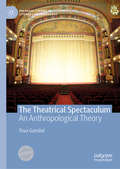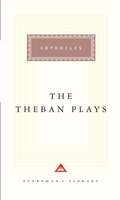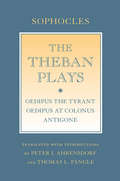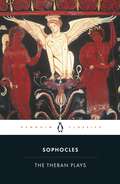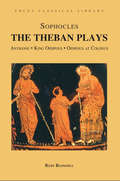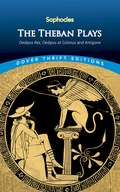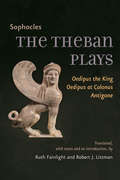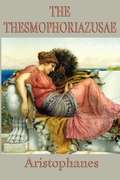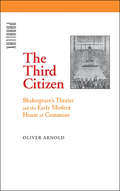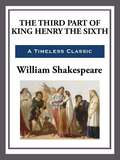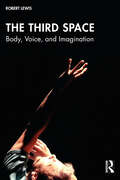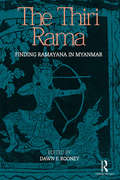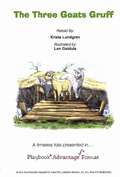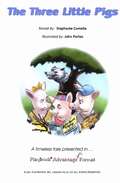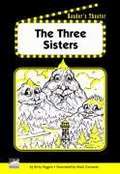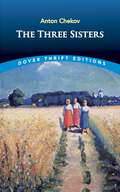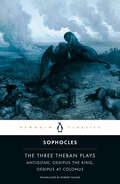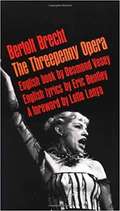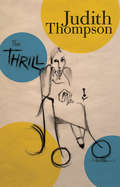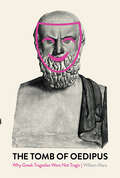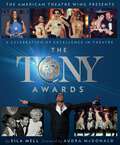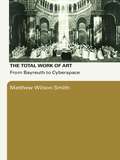- Table View
- List View
The Theatrical Public Sphere
by Christopher B. BalmeThe concept of the public sphere, as first outlined by German philosopher Jürgen Habermas, refers to the right of all citizens to engage in debate on public issues on equal terms. In this book, Christopher B. Balme explores theatre's role in this crucial political and social function. He traces its origins and argues that the theatrical public sphere invariably focuses attention on theatre as an institution between the shifting borders of the private and public, reasoned debate and agonistic intervention. Chapters explore this concept in a variety of contexts, including the debates that led to the closure of British theatres in 1642, theatre's use of media, controversies surrounding race, religion and blasphemy, and theatre's place in a new age of globalised aesthetics. Balme concludes by addressing the relationship of theatre today with the public sphere and whether theatre's transformation into an art form has made it increasingly irrelevant for contemporary society.
The Theatrical Spectaculum: An Anthropological Theory (Palgrave Studies in Literary Anthropology)
by Tova GamlielThis book offers a new mythic perspective on the secret of the allure and survival of a current-archaic institution—the Western theatre—in an era of diverse technological media. Central to the theory is the spectaculum—a stage “world” that mirrors a monotheistic cosmic order. Tova Gamliel here not only alerts the reader to the possibility of the spectaculum’s existence, but also illuminates its various structural dimensions: the cosmological, ritual, and sociological. Its cosmo-logical meaning is a Judeo-Christian monotheistic consciousness of non-randomness, an exemplary order of the world that the senses perceive. The ritual meaning denotes the centrality of the spectaculum, as the theatre repeatedly reenacts the mythical and paradigmatic event of Biblical revelation. Its social meaning concerns any charismatic social theory that is anchored in the epitomic structure of social sovereignty—stage and audience—that the Western theatre advances in an era characterized by hypermedia.
The Theban Plays
by Sophocles David Grene Charles SegalThe legends surrounding Oedipus of Thebes and his ill-fated offspring provide the subject matter for Sophocles' three greatest plays, which together represent Greek drama at the pinnacle of its achievement. Oedipus the King, the most famous of the three, has been characterized by critics from Aristotle to Coleridge as the perfect exemplar of the art of tragedy, in its unforgettable portrayal of a man's failed attempt to escape his fate. In Oedipus at Colonus, the blind king finds his final release from the sufferings the gods have brought upon him, and Antigone completes the downfall of the House of Cadmus through the actions of Oedipus's magnificent and uncompromising daughter defending her ideals to the death. All three of The Theban Plays, while separate, self-contained dramas, draw from the same rich well of myth and showcase Sophocles' enduring power. Translated by David Grene.
The Theban Plays
by Sophocles E. F. WatlingThe legends surrounding the royal house of Thebes inspired Sophocles (496-406 BC) to create a powerful trilogy of mankind's struggle against fate. King Oedipus tells of a man who brings pestilence to Thebes for crimes he does not realise he has committed, and then inflicts a brutal punishment upon himself. With profound insights into the human condition, it is a devastating portrayal of a ruler brought down by his own oath. Oedipus at Colonus provides a fitting conclusion to the life of the aged and blinded king, while Antigone depicts the fall of the next generation, through the conflict between a young woman ruled by her conscience and a king too confident in his own authority. E. F. Watling's masterful translation is accompanied by an introduction, which examines the central themes of the plays, the role of the Chorus, and the traditions and staging of Greek tragedy.
The Theban Plays: "Oedipus the Tyrant"; "Oedipus at Colonus"; "Antigone"
by Sophocles Peter J. Ahrensdorf Thomas L. PangleThe timeless Theban tragedies of Sophocles--Oedipus the Tyrant, Oedipus at Colonus, and Antigone--have fascinated and moved audiences and readers across the ages with their haunting plots and their unforgettable heroes and heroines. Now, following the best texts faithfully, and translating the key moral, religious, and political terminology of the plays accurately and consistently, Peter J. Ahrensdorf and Thomas L. Pangle allow contemporary readers to study the most literally exact reproductions of precisely what Sophocles wrote, rendered in readily comprehensible English.These translations enable readers to engage the Theban plays of Sophocles in their full, authentic complexity, and to study with precision the plays' profound and enduring human questions. In the preface, notes to the plays, and introductions, Ahrensdorf and Pangle supply critical historical, mythic, and linguistic background information, and highlight the moral, religious, political, philosophic, and psychological questions at the heart of each of the plays. Even readers unfamiliar with Greek drama will find what they need to experience, reflect on, and enjoy these towering works of classical literature.
The Theban Plays: Antigone - Oedipus The King - Oedipus At Colonus (hardcover)
by SophoclesKing Oedipus/Oedipus at Colonus/AntigoneThree towering works of Greek tragedy depicting the inexorable downfall of a doomed royal dynastyThe legends surrounding the house of Thebes inspired Sophocles to create this powerful trilogy about humanity's struggle against fate. King Oedipus is the devastating portrayal of a ruler who brings pestilence to Thebes for crimes he does not realize he has committed and then inflicts a brutal punishment upon himself. Oedipus at Colonus provides a fitting conclusion to the life of the aged and blinded king, while Antigone depicts the fall of the next generation, through the conflict between a young woman ruled by her conscience and a king too confident of his own authority.Translated with an Introduction by E. F. WATLING
The Theban Plays: Antigone, King Oidipous and Oidipous at Colonus (Focus Classical Library)
by SophoclesThis anthology includes English translations of three plays of Sophocles' Oidipous Cycle: Antigone, King Oidipous, and Oidipous at Colonus. The trilogy includes an introductory essay on Sophocles life, ancient theatre, and the mythic and religious background of the plays. Each of these plays is available from Focus in a single play edition. Focus Classical Library provides close translations with notes and essays to provide access to understanding Greek culture.
The Theban Plays: Oedipus Rex, Oedipus at Colonus and Antigone (Dover Thrift Editions)
by Sophocles Sir George YoungThe stirring tale of a legendary royal family's fall and ultimate redemption, the Theban trilogy endures as the crowning achievement of Greek drama. Sophocles' three-play cycle, chronicling Oedipus's search for the truth and its tragic results, remains essential reading for English and classical studies majors as well as for all students of Western civilization.Oedipus Rex unfolds amid a city in the relentless grip of a plague. When an oracle proclaims that only an act of vengeance will lift the curse from Thebes, King Oedipus vows to bring a murderer to justice. His quest engenders a series of keen dramatic ironies, culminating in the fulfillment of a dreaded prophecy. Oedipus at Colonus finds the former ruler in exile. Old and blind, he seeks a peaceful place to end his torment, but finds only challenges from his reluctant hosts and a summons back to Thebes from his warring sons. The trilogy concludes with Antigone, in which Oedipus's courageous daughter defies her tyrannical uncle in a provocative exploration of the demands of loyalty and duty. Includes a selection from the Common Core State Standards Initiative: Oedipus Rex.
The Theban Plays: Oedipus the King, Oedipus at Colonus, Antigone (Johns Hopkins New Translations from Antiquity)
by SophoclesSophocles’ Theban Plays—Oedipus the King, Oedipus at Colonus, and Antigone—lie at the core of the Western literary canon. They are extensively translated, universally taught, and frequently performed. Chronicling the downfall of Oedipus, the legendary king of Thebes, and his descendants, the Theban Plays are as relevant to present-day thought about love, duty, patriotism, family, and war as when they were written 2,500 years ago.Recent translations of the plays, while linguistically correct, often fail to capture the beauty of Sophocles’ original words. In combining the skills of a distinguished poet, Ruth Fainlight, and an eminent classical scholar, Robert J. Littman, this new edition of the Theban Plays is both a major work of poetry and a faithful translation of the original works. Thoughtful introductions, extensive notes, and glossaries frame each of the plays within their historical contexts and illuminate important themes, mythological roots, and previous interpretations.This elegant and uncommonly readable translation will make these seminal Greek tragedies accessible to a new generation of readers.
The Theban Plays: Sophocles
by David Grene Charles Segal James Hogan(Book Jacket Status: Jacketed)The legends surrounding Oedipus of Thebes and his ill-fated offspring provide the subject matter for Sophocles' three greatest plays, which together represent Greek drama at the pinnacle of its achievement.Oedipus the King, the most famous of the three, has been characterized by critics from Aristotle to Coleridge as the perfect exemplar of the art of tragedy, in its unforgettable portrayal of a man's failed attempt to escape his fate. In Oedipus at Colonus, the blind king finds his final release from the sufferings the gods have brought upon him, and Antigone completes the downfall of the House of Cadmus through the actions of Oedipus's magnificent and uncompromising daughter defending her ideals to the death. All three of The Theban Plays, while separate, self-contained dramas, draw from the same rich well of myth and showcase Sophocles' enduring power.Translated by David Grene.From the Hardcover edition.
The Thesmophoriazusae
by AristophanesThesmophoriazusae was performed in Athens in 411 BCE, most likely at the City Dionysia, and is among the most brilliant of Aristophanes' eleven surviving comedies. It is the story of the crucial moment in a quarrel between the tragic playwright Euripides and Athens' women, who accuse him of slandering them in his plays and are holding a meeting at one of their secret festivals to set a penalty for his crimes. Thesmophoriazusae is a brilliantly inventive comedy, full of wild slapstick humour and devastating literary parody, and is a basic source for questions of gender and sexuality in late 5th-century Athens and for the popular reception of Euripidean tragedy.
The Third Citizen: Shakespeare's Theater and the Early Modern House of Commons (Parallax: Re-visions of Culture and Society)
by Oliver ArnoldThe new practices and theories of parliamentary representation that emerged during Elizabeth's and James' reigns shattered the unity of human agency, redefined the nature of power, transformed the image of the body politic, and unsettled constructs and concepts as fundamental as the relation between presence and absence. In The Third Citizen, Oliver Arnold argues that recovering the formation of political representation as an effective ideology should radically change our understanding of early modern political culture, Shakespeare's political art, and the way Anglo-American critics, for whom representative democracy is second nature, construe both. In magisterial readings of Titus Andronicus, Julius Caesar, Coriolanus, and the First Tetralogy, Arnold discovers a new Shakespeare who was neither a conservative apologist for monarchy nor a prescient, liberal champion of the House of Commons but instead a radical thinker and artist who demystified the ideology of political representation in the moment of its first flowering. Shakespeare believed that political representation produced (and required for its reproduction) a new kind of subject and a new kind of subjectivity, and he fashioned a new kind of tragedy to represent the loss of power, the fall from dignity, the false consciousness, and the grief peculiar to the experiences of representing and of being represented. Representationalism and its subject mark the beginning of political modernity; Shakespeare’s tragedies greet political representationalism with skepticism, bleakness, and despair.
The Third Part of King Henry the Sixth
by William ShakespeareThe play begins with a confrontation between Richard, Duke of York (the future King Richard III), the reigning King Henry VI and their respective supporters. Threatened with physical violence by the Earl of Warwick (Richard Neville), the king brokers a deal to make York his heir. Disgusted at his cowardice, his supporters abandon him. The Queen, Margaret of Anjou, makes it clear that she will not agree to this, and declares war on the Yorkists, with the assistance of the young Lord Clifford and other supporters, including her son, Edward, Prince of Wales.
The Third Space: Body, Voice, and Imagination
by Robert LewisThe Third Space serves a crucial need for contemporary performers by providing an interdisciplinary and physiovocal approach to training. It is a new take on body and voice integration designed to develop the holistic performer. It takes performers through a series of step-by-step practical physiovocal exercises that connects the actor’s centre to the outside world, which increases awareness of self and space. It also develops a deeper connection between spaces within the body and the environment by connecting sound, imagination, and movement.Robert Lewis’s approach is a way of working that unlocks the imagination as well as connecting performers to self, space, and imagination, through voice and body. It conditions, controls, and engages performers by integrating various voice and movement practices.The theories and practice are balanced throughout by: introducing the practical works theoretical underpinnings through research, related work, and case studies of performances; demonstrating a full program of exercises that helps performers get in touch with their centre, their space, and shape both within and outside the body; and exploring the performers physiovocal instrument and its connection with imagination, energies, and dynamics. This book is the result of nearly 20 years of research and practice working with voice and movement practitioners across the globe to develop training that produces performers that are physiovocally ready to work in theatre, screen, and emergent technologies.
The Thiri Rama: Finding Ramayana in Myanmar
by Dawn RooneyThe Thiri Rama – or the Great Rama – was written for court performance and is the only known illustrated version of the Ramayana story in Myanmar. Based on palm-leaf manuscripts and scenes carved on over 300 sandstone plaques at a mid-nineteenth-century Buddhist pagoda west of Mandalay in Myanmar, this book presents an original translation of the Thiri Rama rendered in prose. The volume also includes essays on the history and tradition of the Ramayana in Myanmar as well as the cultural context in which the play was performed. It contains many helpful resources, incorporating a glossary and a list of characters and their corresponding personae in Valmiki’s Ramayana. With over 250 fascinating visuals and core text contributions by distinguished Burmese scholars, U Thaw Kaung, Tin Maung Kyi, and U Aung Thwin, this book will greatly interest scholars and researchers of South and Southeast Asian culture, literary forms, epics, art and art history, theatre and performance studies, religion, especially those concerned with Hinduism, as well as folklorists.
The Three Goats Gruff Go to the Greener Side
by Krista Lundgren Len GatdulaWelcome to the world of Playbooks® and the beginning of a wonderful role-play reading adventure! Playbook® stories are presented in a unique and colorful format and are read out loud by several readers like a play, without memorization, props, or a stage. <p><p>When you read a Playbook®, you and other readers bring the story to life and become the characters. As you read your part out loud, you will have fun expressing and acting like your character. You and the other readers will explore the story plot together and learn what will happen next. It's an exciting journey of discovery that pulls you into the story, and you'll want to read it out loud again and again!
The Three Little Pigs
by Stephanie Cornelia John PortezWelcome to the world of Playbooks® and the beginning of a wonderful role-play reading adventure! Playbook® stories are presented in a unique and colorful format and are read out loud by several readers like a play, without memorization, props, or a stage. <p><p> When you read a Playbook®, you and other readers bring the story to life and become the characters. As you read your part out loud, you will have fun expressing and acting like your character. You and the other readers will explore the story plot together and learn what will happen next. It's an exciting journey of discovery that pulls you into the story, and you'll want to read it out loud again and again!
The Three Sisters
by Mark Corcoran Anne Flounders Kitty HigginsPerform this script about the eruption of a long-dormant volcano and the earthquake that followed the eruption.
The Three Sisters: A Drama In Four Acts (Dover Thrift Editions: Plays)
by Anton ChekhovFirst performed at the Moscow Art Theatre in 1901, The Three Sisters probes the lives and dreams of Olga, Masha, and Irina, former Muscovites now living in a provincial town from which they long to escape. Their hopes for a life more suited to their cultivated tastes and sensibilities provide a touching counterpoint to the relentless flow of compromising events in the real world.In this powerful play, a landmark of modern drama, Chekhov masterfully interweaves character and theme in subtle ways that make the work's climax seem as inevitable as it is deeply moving. It is reprinted here from a standard text with updated transliteration of character names and additional explanatory footnotes.
The Three Theban Plays: Antigone; Oedipus the King; Oedipus at Colonus
by Sophocles Bernard Knox Robert FaglesThe heroic Greek dramas that have moved theatergoers and readers since the fifth century B.C.Towering over the rest of Greek tragedy, the three plays that tell the story of the fated Theban royal family—Antigone, Oedipus the King and Oedipus at Colonus—are among the most enduring and timeless dramas ever written. Robert Fagles's authoritative and acclaimed translation conveys all of Sophocles's lucidity and power: the cut and thrust of his dialogue, his ironic edge, the surge and majesty of his choruses and, above all, the agonies and triumphs of his characters. This Penguin Classics edition features an introduction and notes by the renowned classicist Bernard Knox.For more than seventy years, Penguin has been the leading publisher of classic literature in the English-speaking world. With more than 1,700 titles, Penguin Classics represents a global bookshelf of the best works throughout history and across genres and disciplines. Readers trust the series to provide authoritative texts enhanced by introductions and notes by distinguished scholars and contemporary authors, as well as up-to-date translations by award-winning translators.
The Threepenny Opera
by Nadine Gordimer Ralph Manheim Bertolt Brecht John Willett Norman RoesslerBased on John Gay's eighteenth century Beggar's Opera, The Threepenny Opera, first staged in 1928 at the Theater am Schiffbauerdamm in Berlin, is a vicious satire on the bourgeois capitalist society of the Weimar Republic, but set in a mock-Victorian Soho. With Kurt Weill's unforgettable music - one of the earliest and most successful attempts to introduce jazz to the theatre - it became a popular hit throughout the western world. <p><p> Published in Methuen Drama's Modern Classics series, this edition features extensive notes and commentary including an introduction to the play, Brecht's own notes on the play, a full appendix of textual variants, a note by composer Kurt Weill, a transcript of a discussion about the play between Brecht and a theatre director, plus editorial notes on the genesis of the play.
The Thrill
by Judith ThompsonElora Dixon is a vibrant, middle-aged lawyer and disability-rights activist who has never walked a step in her life. A neuromuscular disease left her with a curved spine and a reliance on around-the-clock care. Nonetheless, she is an inexorable force when chance pits her against the notorious Julian Summer, who is in town promoting his internationally bestselling book. Julian is a fervent supporter of euthanasia, and Elora is the counter-argument—a living rebuke to parents who want the option of euthanizing a disabled newborn. So it comes as a shock, especially to Elora, when the two find themselves acutely attracted to one another. Will she learn to negotiate her feelings and her convictions, or will Julian’s beliefs begin to colour her own?
The Tomb of Oedipus: Why Greek Tragedies Were not Tragic
by Wililam MarxNearly Everything We Think We Know about Greek Tragedy Is WrongIf Greek tragedies are meant to be so tragic, why do they so often end so well? Here starts the story of a long and incredible misunderstanding. Out of the hundreds of tragedies that were performed, only 32 were preserved in full. Who chose them and why? Why are the lost ones never taken into account? This extremely unusual scholarly book tells us an Umberto Eco-like story about the lost tragedies. By arguing that they would have given a radically different picture, William Marx makes us think in completely new ways about one of the major achievements of Western culture. In this very readable, stimulating, lively, and even sometimes funny book, he explores parallels with Japanese theatre, resolves the enigma of catharsis, sheds a new light on psychoanalysis. In so doing, he tells also the story of the misreadings of our modernity, which disconnected art from the body, the place, and gods. Two centuries ago philosophers transformed Greek tragedies into an ideal archetype, now they want to read them as self-help handbooks, but all are equally wrong: Greek tragedy is definitely not what you think, and we may never understand it, but this makes it matter all the more to us.
The Tony Awards: A Celebration of Excellence in Theatre
by Eila Mell The American Theatre WingCommemorating over 75 years of Broadway greatness with never-before told stories, rare photos from the American Theatre Wings' archives, and interviews with major honorees like Lin-Manuel Miranda, Patti LuPone, and Hugh Jackman, The Tony Awards is the official, authorized guide to Broadway's biggest night.The Tony Awards: A Celebration of Excellence in Theatre pays tribute to the magic that happens when the curtain goes up and Broadway's best and brightest step onto center stage. Supported by the American Theatre Wing, the arts organization that founded the Tony Awards in 1947 and continues to produce the Tony Awards live telecast each year, author Eila Mell has interviewed a cavalcade of past and present Tony winners, including actors, producers, writers, costume designers, and many many others. Their voices fill the pages of this book with fascinating, behind-the-scenes stories about what it's like to win the theatre world's highest honor. Featuring a foreword by Audra McDonald and over 400 color and black-and-white photographs, The Tony Awards also spotlights more than 130 captivating interviews with a parade of industry insiders, including: Mel Brooks, Matthew Broderick, Carol Burnett, Kristin Chenoweth, Glenn Close, James Corden, Bryan Cranston, Neil Patrick Harris, Jennifer Holliday, Hugh Jackman, John Kander, Angela Lansbury, Judith Light, Hal Linden, Kenny Leon, Patti LuPone, Lin-Manuel Miranda, Brian Stokes Mitchell, Rita Moreno, Bernadette Peters, Chita Rivera, Martin Short, Tom Stoppard, Julie Taymor, Leslie Uggams, and Sir Andrew Lloyd Webber.
The Total Work of Art: From Bayreuth to Cyberspace
by Matthew Wilson SmithThe Total Work of Art provides a broad survey that incorporates many canonical artists into a single narrative. With particular attention to the influence of the Total Work of Art on modern theatre and performance, this brief introduction will also be of interest to students in such fields as film studies, music history, history of art, cultural studies, and modern European literatures.

